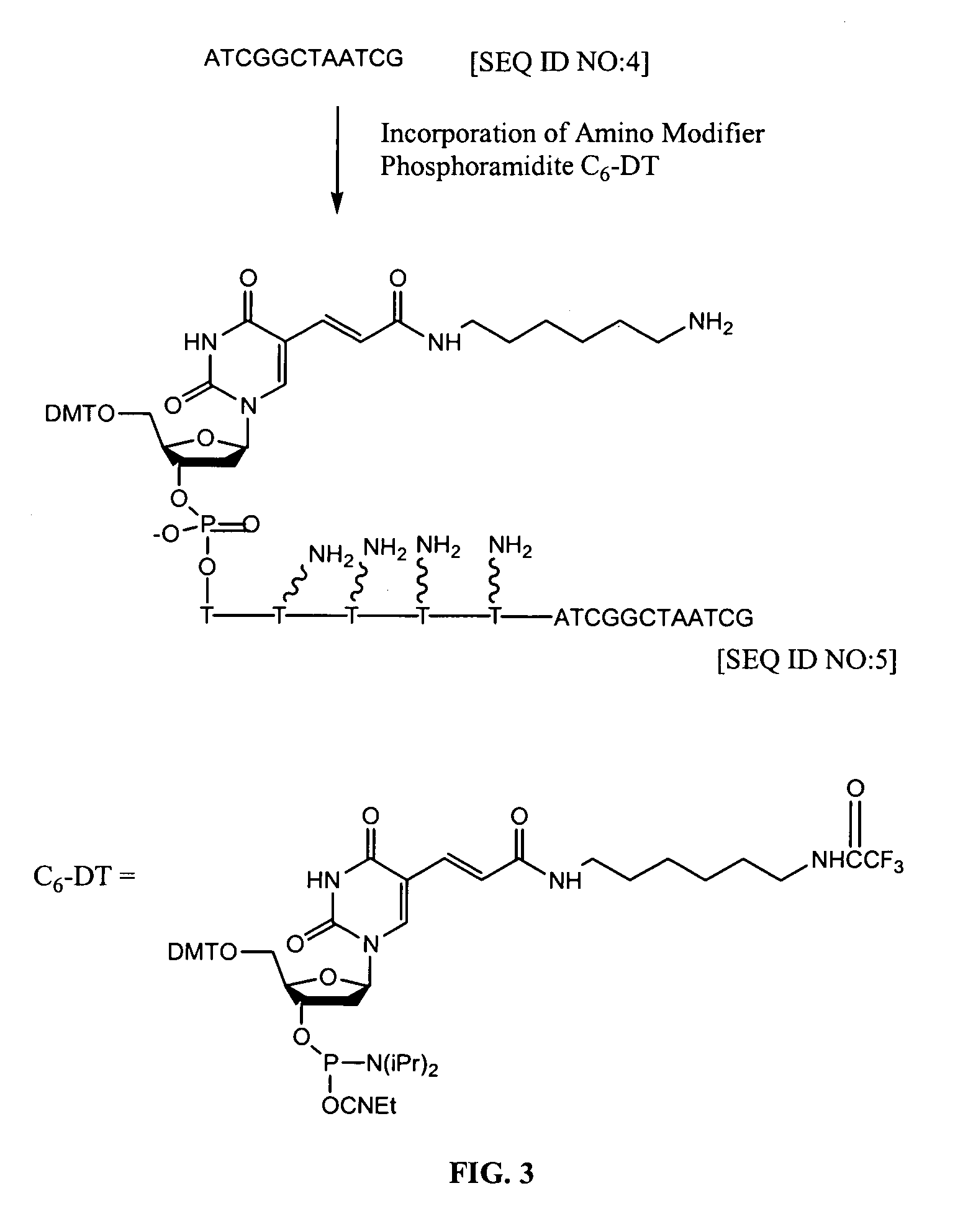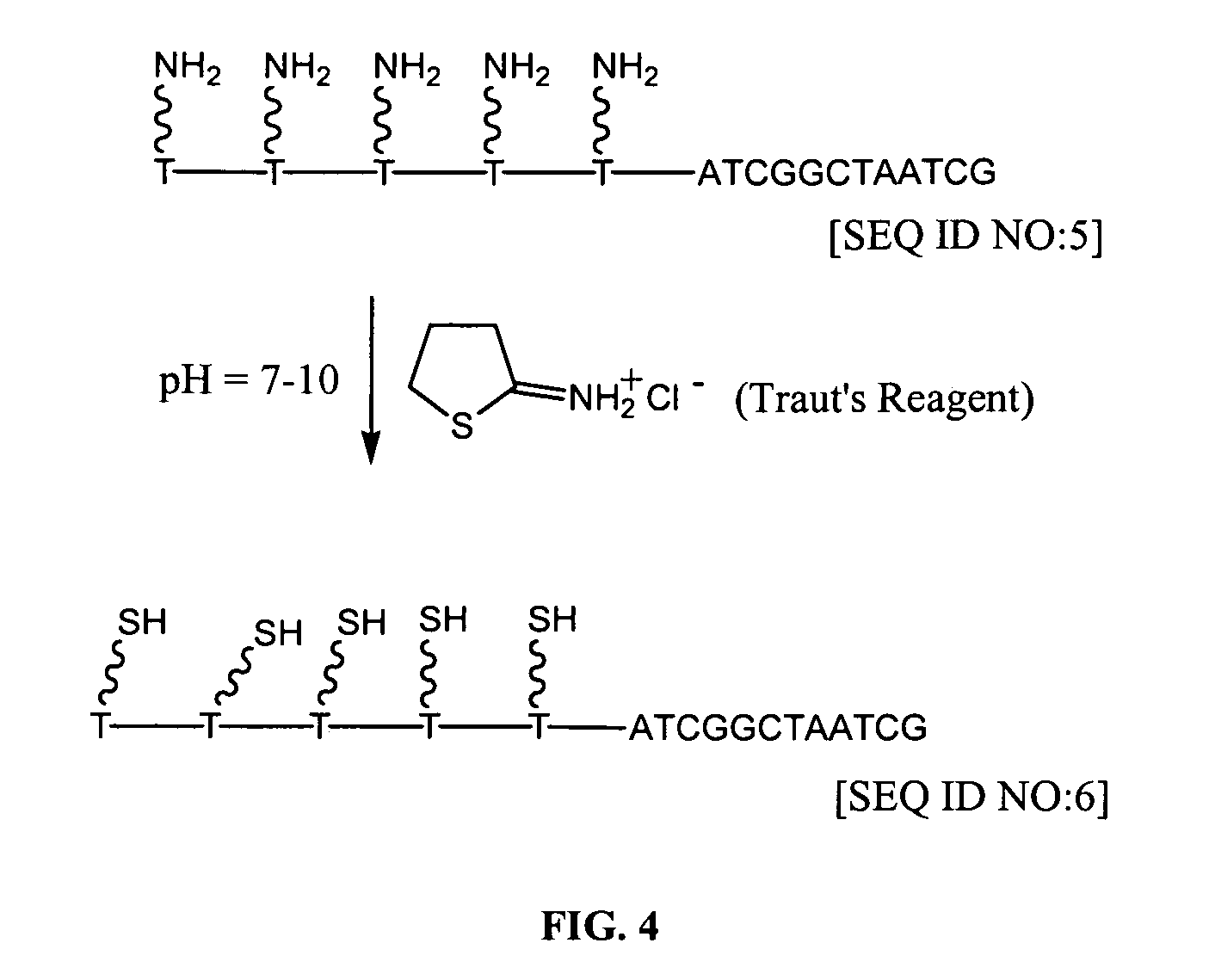Bioconjugate-nanoparticle probes
a bioconjugate and nanoparticle technology, applied in the field of stable bioconjugate and nanoparticle probes, can solve the problem that oligonucleotides are easily detached from the nanoparticle surfa
- Summary
- Abstract
- Description
- Claims
- Application Information
AI Technical Summary
Problems solved by technology
Method used
Image
Examples
synthesis examples
Example 1
Introduction of Amino Groups
[0099]In this example, amino modifier C6-DT groups are introduced into an oligonucleotide using an amino modifier phosphoramidite (available from Glen Research, Sterling, Va.) (FIG. 3).
[0100]Protocol. The amino modifier C6-dT reacts in a manner identical to normal phosphoramidites, i.e., standard automated oligonucleotide synthesis. The trifluoroacetyl (TFA) protecting group on the primary amine is removed during standard ammonium hydroxide deprotection. However, a minor side reaction during ammonia deprotection can lead to irreversibly capping 2–5% of the amine. To prevent this reaction, the synthesis is carried out using acetyl-protected dC and deprotection is carried out in 30% ammonia / 40% methylamine 1:1 (AMA) at 65° C. for 15 minutes.
example 2
Introduction of Thiol Groups
[0101]In this example, the amine containing oligonucleotide prepared in Example 1 is reacted with 2-iminothiolane.HCl (Traut's Reagent, available from Pierce Chemical Company, Rockford, Ill.) to introduce thiol groups (FIG. 4).
[0102]Protocol. The amine containing oligonucleotide prepared in Example 1 is first purified by reverse phase HPLC and is then dissolved in 50 mM triethanolamine-HCl buffer of pH 8 (or other pH 8 buffer such as 0.16 M Borate of 10 mM phosphate). A 2–10 fold molar excess of 2-iminothiolane-HCl is added. The solution is incubated for 20–60 minutes at 0–25° C. The thiolated amine oligonucleotide is then separated from the amine oligonucleotide using reverse-phase HPLC (0.03 M TEAA buffer (pH 7) with a 1% / min gradient of 95:5 acetonitrile / 0.03 M TEAA (pH 7)).
[0103]Alternatively, the following protocol can be used. The amine containing oligonucleotide is first purified by reverse-phase HPLC. After purification, the oligonucleotide is re-...
example 3
Alternative Protocol for Introduction of Thiol Groups
[0104]This example presents an alternative method for introducing thiol groups into an oligonucleotide. An amine reactive bifunctional crosslinker, e.g., glutaraldehyde, and a heterobifunctional group such as an alkyl thiol amine are reacted with the amine functionalized oligonucleotide prepared in Example 2, to create thiol groups (FIG. 5).
[0105]Protocol. The amine containing oligonucleotide is first purified be reverse-phase HPLC. After purification, the oligonucleotide is redissolved in a phosphate or borate buffer (pH 6–9) containing 10% glutaraldehyde and allowed to stand for 1–2 hours. Next, the oligonucleotide is purified through a NAP-10 column to remove excess glutaraldehyde and eluted in pH 6–9 phosphate or borate buffer. A 10–100 fold excess of mercaptoethylamine is then reacted with the oligonucleotide for 2–4 hours at room temperature, followed by addition of sodium cyanoborohydride to create a 10% solution for 5 min ...
PUM
| Property | Measurement | Unit |
|---|---|---|
| Time | aaaaa | aaaaa |
| Magnetism | aaaaa | aaaaa |
| Affinity | aaaaa | aaaaa |
Abstract
Description
Claims
Application Information
 Login to View More
Login to View More - R&D
- Intellectual Property
- Life Sciences
- Materials
- Tech Scout
- Unparalleled Data Quality
- Higher Quality Content
- 60% Fewer Hallucinations
Browse by: Latest US Patents, China's latest patents, Technical Efficacy Thesaurus, Application Domain, Technology Topic, Popular Technical Reports.
© 2025 PatSnap. All rights reserved.Legal|Privacy policy|Modern Slavery Act Transparency Statement|Sitemap|About US| Contact US: help@patsnap.com



